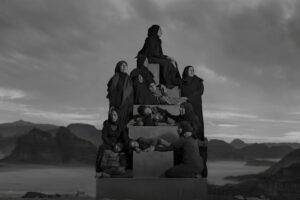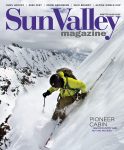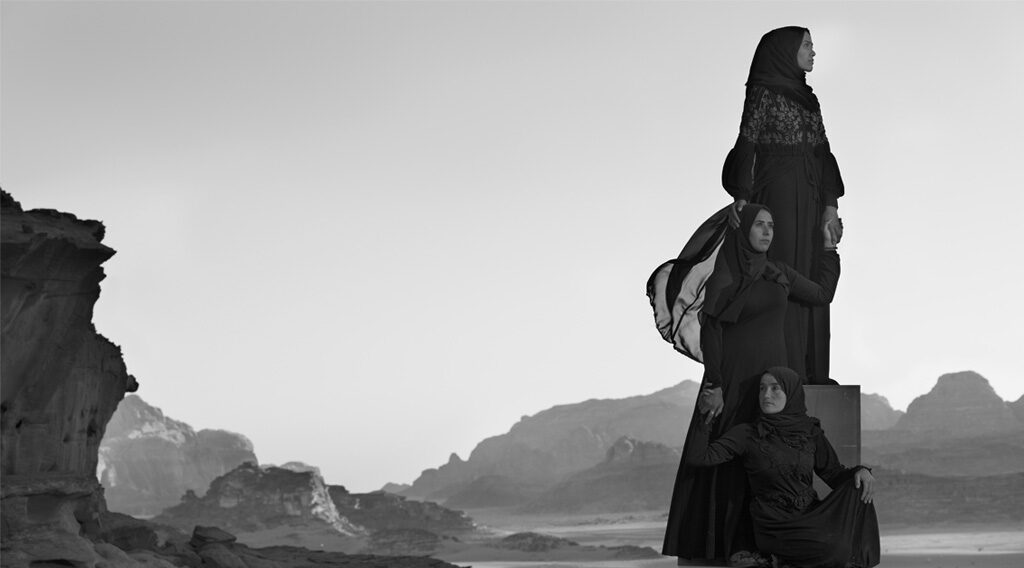Today, over 600,000 Syrian refugees are living in Jordan. Displaced by the civil war more than a decade ago, many who fled violence now face the devastating effects of the climate crisis. In Jordan, the second most water-scarce country on the planet, drought makes rainfall scarce. These refugees, most of whom rely on agricultural work, must move as many as five times a year in ceaseless pursuit of arable land.
English photographer and climate activist Nick Brandt’s latest work, “The Echo of Our Voices: The Day May Break Chapter Four” (2024,) explores the transformative power of human connection in the face of adversity. This chapter in his ongoing global series (on display at Gilman Contemporary until January 23, 2025) features portraits of 21 Syrian families standing atop boxes, which Brandt views as “pedestals for the unseen and unheard,” amplifying voices often ignored.
Brandt began his project with several weeks of travel around Jordan, cultivating trust with refugees – promising that at their most vulnerable, he would honor their struggle and capture them with dignity and respect. Brandt transported more than 170 family members to Jordan’s Wadi Rum desert, working for six weeks with as many as 40 individuals a day in a process he describes as “photographic jazz.”
Through careful posing and reconfiguration of the blocks, Brandt worked “to capture the genuine connection between father and daughter or mother and son… through these human sculptures.” Hopefully, he added, in a way that “feels both genuine and surprising in its execution.”
“I became a photographer to express my feelings about the destruction of the natural world,” said Brandt. He took what he describes as a “15-year detour” in directing, saying his career in photography really began in 2001 with a trilogy of work titled “On This Earth,” which memorialized the loss of wildlife wilderness and exposed the tragic consequences of human “progress” in East Africa from 2001 to 2012.
Each chapter of the three-part series, “On This Earth,” “A Shadow Falls,” and “Across the Ravaged Land,” explores, in sequence, the growing threat to wildlife survival due to human activity, the looming destruction of ecosystems by urbanization, and the direct impact of environmental degradation on the suffering of both animals and humans.

His next works, “Inherit the Dust” (2015) and “This Empty World” (2017), were shot in Kenya and Bolivia, respectively. Both showcase the haunting, abandoned remnants of wildlife habitats where animals once thrived and the desolation left behind by human exploitation and industrialization.
All of Brandt’s work explores the dire consequences of the climate crisis, but chapters one and two of “The Day May Break” (2020 and 2022) mark a shift in focus – taking humans as his primary subjects, he reveals the unmediated connection between human suffering and environmental collapse. The third chapter, “SINK/RISE,” depicts Pacific Islanders on sofas, at tables with family – vignettes of what could be their ordinary lives, plunged underwater. Shot off the coast of the Fijian islands, the scenes are a haunting representation of the loss of land and livelihood to rising sea levels.
Brandt’s human subjects make the impacts of climate disruption not just visible but personal. His images communicate the emotional toll of climate change, showing how human lives are increasingly shaped by environmental factors beyond their control, reflecting both the personal and collective anguish of people living in climate-vulnerable areas.
Beyond flooding, extreme weather events, frequent intense droughts, and disruptions to agriculture and food security, Brandt’s work explores the broader, uniquely human implications of climate change: how changes in our environment lead to cultural erosion and historical rupture as people are forced to move away from lands that have sustained them for generations.
While much of Brandt’s work is deeply sobering, it is not devoid of hope. Though his images often capture profound suffering and loss, they are also imbued with a sense of courage. Brandt’s subjects demand awareness and call for action.
“In spite of their loss, these people and animals are the survivors,” Brandt said of “The Day May Break.”
Brandt creates striking, evocative visual narratives that transcend traditional boundaries. By elevating his often- overlooked subjects to the realm of fine art while anchoring their portrayal in the truth of documentary, Brandt urges viewers to regard the plight of these populations with the same seriousness and empathy as they would their own.
In Jordan for “Echo of Our Voices,” Brandt would sit up each night reviewing the day’s photographs, trying and trying again to find the delicate equilibrium between authentic moments of familial connection and sculptural composition.
The resulting photographs are alive with the profound strength and stability our relationships provide in the tempest of grief. “When all else is lost, you still have each other,” Brandt said, reflecting the project’s central theme.
Against a mountainous desert background, these human sculptures mirror the landscape. They hold on to one another, “not in weakness,” said Brandt, “but with strength and defiance.” In lives marred by near-constant motion, here they are still – at rest in the embrace of those that are dearest to them.


